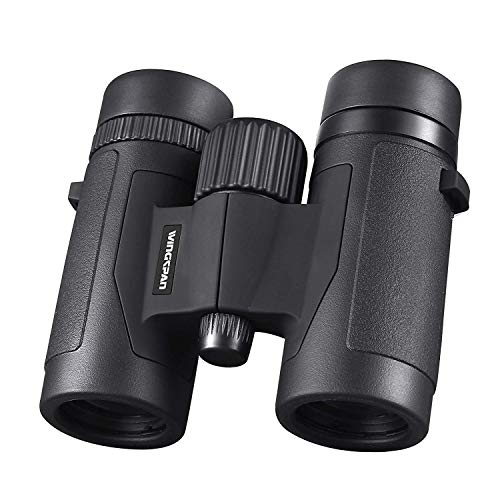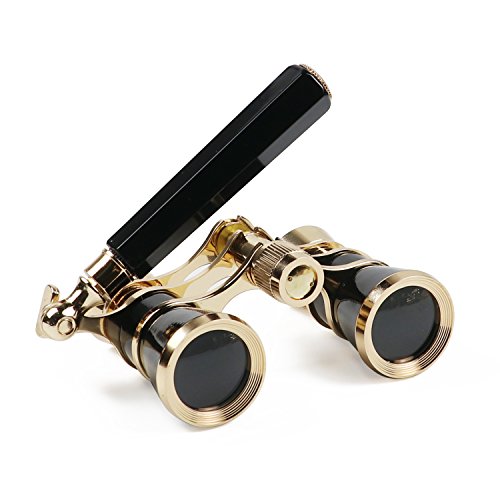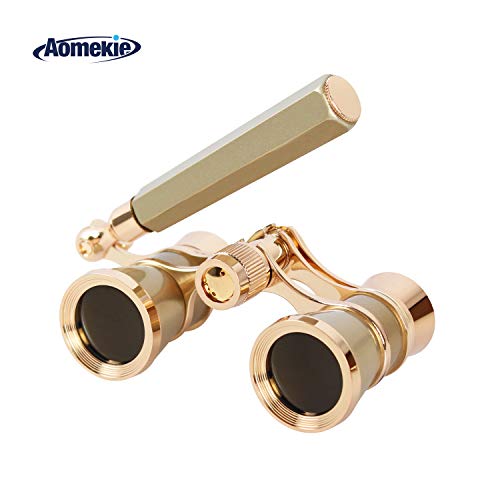6 Best Binoculars for Theater & Opera of 2025 – Reviews & Top Picks
Last Updated on
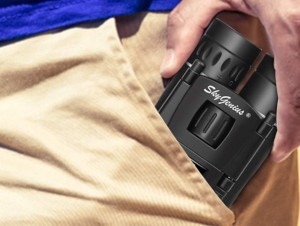
Binoculars for the theater have to meet different criteria than binoculars for bird watching. For starters, they need to look right for the setting. If they’re too big, you’ll look unsophisticated. They have to look sleek, even elegant, while also helping you see what’s on stage.
Theater glasses once had a certain look to them. Today, there’s so much variety available that you can either go with a classic look or one that’s more up-to-date.
We reviewed some binoculars that you might take to the theater to see a play or an opera. We hope you find this helpful in getting binoculars that not only help you keep track of what’s happening on stage, but also help you look like you belong there.

Comparison of Our Favorite Products (Updated in 2025)
| Image | Product | Details | ||
|---|---|---|---|---|
| Best Overall |
 |
Pentax Papilio II |
|
CHECK PRICE |
 |
Wingspan 8×32 |
|
CHECK PRICE | |
| Best Value |
 |
Kingscope Vintage |
|
CHECK PRICE |
 |
Aomekie Opera |
|
CHECK PRICE | |
 |
Skygenius 8×21 |
|
CHECK PRICE |
The 6 Best Binoculars for Theater & Opera
1. Pentax Papilio II Theater Binoculars – Best Overall
No compact set of binoculars projects class and elegance while also letting you feel like you’re right on stage like the Pentax Papilio II. They’re great for lots of applications outside, which means they’re great for indoor use, too.
They aren’t so powerful that you’ll be counting nose hairs during the aria, which we like. They’re also small enough to stash away comfortably during intermissions. Binoculars for the theater need to accentuate your outfit and complement your taste in addition to letting you see the action, and this pair does that. Of course, you’ll pay real money for that. This is easily the most expensive set of binoculars we looked at.
- Sleek appearance
- Powered perfectly for the stage
- Great imaging
- Really expensive
2. Wingspan 8×32 Compact Binoculars
We like the Wingspan Optics Spectator quite a bit, and if this was a review of birdwatching binoculars, this set might well take the top spot. But it’s a review of binoculars for the theater or opera, and while these are powerful binoculars with great optics, we just don’t think they have the mettle to be our top pick.
We like their weight. They’re among the most lightweight binoculars on the market. The optics are sharp and clear. We also like the cost based on what they provide. It’s a good deal.
But, for the theater, they’re possibly a little too powerful. Ideally, you’d want something with a magnification rating (the first number) of maybe five or six. Your distance from the stage is pretty static, and you’re not watching high-speed birds flit around a meadow. You’re watching people. These may be too powerful for that.
- Good optics
- Lightweight
- Good value
- Also good for concerts
- More powerful than needed
3. Kingscope Vintage Opera Binoculars – Best Value
The Kingscope 3×25 has one intention, which is the theater. It has a look that harkens back to before the multi-screen theater. If you want to look old school, this set with its neutral red color scheme is a great choice. It’s also our choice for best for the money because of its price and basic function as theater optics.
One thing we like is the foldable handle. It doesn’t have a lot of utility, but it does add to the look.
In fact, we’d rate these as primarily ornamental glasses rather than ones you use. The 3x magnification is adequate if you’re not too far away from the stage, but may be a little low if you’re back some. It also limits your ability to use them outside a theater setting. If you don’t get to the theater very often, these will collect dust. But they’ll look good doing it.
Overall, these are some of the best opera glasses on the market right now.
- Elegant look
- Great value
- Limited utility
- Not the greatest images
See More Vintage Binoculars – Here!
4. Aomekie Opera Binocular Glasses (3×25)
Since they’re designed in function and appearance for the theater, the Aomekie Opera Glasses are a good choice for theater binoculars. They update the traditional theater glasses look by replacing the long handle with a chain to put around your neck, and they’re red and gold, so they’ll go with just about any classic look when it comes to outfits.
We like the price because most people don’t go to the theater that often. You don’t want to spend a lot of money on theater glasses because of it. We also like that they’re clearly specially designed for the theater. They’re powerful enough to see what’s happening, but not so powerful that you’ll feel like you’re sharing intimate details with the performers.
If you’re looking for glasses that can be used for multiple things, however, this isn’t your set. We also think that they look cheap.
- Inexpensive
- Designed for theater use
- Limited use
- Kind of gaudy-looking
5. Skygenius 8×21 Lightweight Binoculars
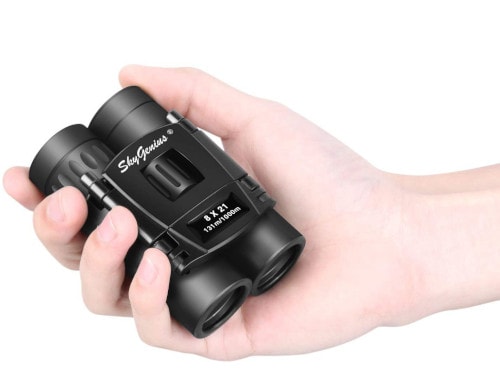
We don’t hate the Skygenius 8×21 compact binoculars. In fact, we really like them. We just don’t see them as being very good for the theater.
These binoculars offer great, powerful optics in a very compact frame. You can practically palm these and use them for things like birding while on a day hike. They are good, affordable, multifunction binoculars.
But they aren’t very well suited to use in the theater. They’re more powerful than you need, plus they have a very outdoorsy look to them. If you’re in your finest set of duds, you’ll want something that looks more the part.
- Multifunctional
- Affordable
- Easy to use
- Has an outdoors look
- More power than you need
6. Levenhuk 325C Opera Glasses / Binoculars
Levenhuk’s Broadway 325C is a serviceable pair of binoculars that you could take to the theater and see what’s happening on stage perfectly well. But the question that remains unanswered is why you would.
These glasses have color-correcting lenses and do a good job of providing a closer, sharper look at what you’re trying to see. You wouldn’t want to use them for birding with or identifying what kind of butterfly is flitting through your garden, but for watching the third act, they’re pretty good.
However, they’re pretty expensive compared to other binoculars for this purpose. We also don’t like the color options. They might work if you have a very specific look you’ve crafted, but not so much if you’re after a muted, sober appearance.
- Color-correcting lenses
- Expensive
- Gaudy
Related Reads: we also compared dozens of binoculars for sports event viewing

Conclusion
If you can handle the price, we really recommend the Pentax Papilio II binoculars. They were easily the best of the models we reviewed and have a sharp, elegant look. If you’re looking for an alternative, we’d suggest the Wingspan Optics Spectator. It doesn’t look as cool, but the price is a little more reasonable. For the cost, we liked the Kingscope 3×25 the best. It will let you scope out the action at a wallet-friendly price. The Aomekie Opera Glasses look like traditional theater glasses so you can take in the show, but they aren’t terribly precise. The Skygenius 8×21 binoculars are compact, but look a little crude for our tastes, and the Levenhuk Broadway 325C just broadcasts things about your taste that we’d prefer to not go into.
We hope you found these reviews valuable as a good set of tips and recommendations in what to look for in binoculars for the theater and opera. We wish you a great purchase and lots of fun at the theater.
About the Author Robert Sparks
Robert’s obsession with all things optical started early in life, when his optician father would bring home prototypes for Robert to play with. Nowadays, Robert is dedicated to helping others find the right optics for their needs. His hobbies include astronomy, astrophysics, and model building. Originally from Newark, NJ, he resides in Santa Fe, New Mexico, where the nighttime skies are filled with glittering stars.
Related Articles:
Binocular Magnification Chart: Numbers & Distances Compared
When Were Binoculars Invented? History, Today & Future
How to Clean a Refractor Telescope: Step-by-Step Guide
How to Clean a Telescope Eyepiece: Step-by-Step Guide
How to Clean a Rifle Scope: 8 Expert Tips
Monocular vs Telescope: Differences Explained (With Pictures)
What Is a Monocular Used For? 8 Common Functions
How to Clean a Telescope Mirror: 8 Expert Tips





